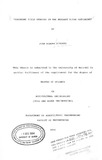| dc.description.abstract | The Mathare catchment comprises an area of 26 Km2 and is
located in the Western suburbs of Nairobi, Kenya. It is
currently fitted with instruments for both rainfall
measurement and runoff gauging at the Kabete field station.
For the purpose of sediment gauging, a bridge was constructed
for sediment sampling; two sets of staff gauges installed and
a steel container erected for storage of equipment.
Suspended sediment concentration in the river was
estimated using four methods; the grab method, the equal
discharge increment method, the equal transit rate method and
the automatic single stage bottle sampling method. It was
observed that there was no significant difference in
statistical sense between the first three methods. The
single stage automatic bottle sampler showed significant
deviation in relation to the grab method.
As a tool for the development of simple field gauging
techniques, three methods of discharge measurement, the
conventional multi-vertical current meter method, the single
point velocity method and the equal transit rate sampling
methods were investigated. It was found out that they all
yield significantly different results and the last two
required calibration to become useful for gauging.
For this catchment, the instantaneous unit sediment
graph (IUSG) was developed and tested for the prediction of
sediment discharge. This involved development and analysis
of the river discharge rating equation and the sediment
graphs. The developed IUSG model produced a lower sediment
yield in comparison to that derived from the temporal
concentration graph and the flow duration curve analysis
methods. The IUSG model based on the multireservoir
cascading concept simulated the sediment graphs more
accurately than that based on the time area histograms routed
through a single reservoir concept.
For the period 27/10/92 to 15/9/93, (324 days) the
total estimated sediment yield of the Mathare catchment was
140, 150 and 165 tonnes by IUSG, temporal concentration
analysis and flow duration curve analysis methods
(uncorrected sediment rating curve) respectively. For the
flow duration curve method, with the sediment rating equation
adjusted by the correction factor (arising due to the lognormal
distribution of the error component in the rating
equation), a sediment yield estimate of 179.2 tonnes was
obtained. The mean sediment production rate was found to be
approximately 6.9 tonnes/km2/yr. Such a low estimate of
sediment yield reflects the high level of conservation
practices prevalent in the catchment. It is likely that the
Mathare reservoir is still in healthy state in terms of
siltation. The particle size distribution suggested that the
total sediment load of the Mathare river comprises of
suspended component with negligible bed load. | en |

